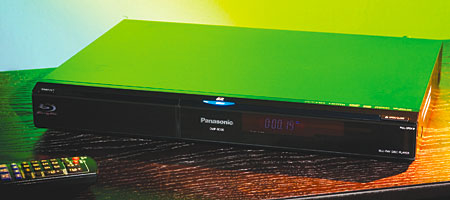Blu-ray’s Identity Crisis
Although I don’t usually pay attention to such things, the other day as I was opening a recent Blu-ray purchase, I took note of the “Compatible with PlayStation 3” sticker that either the studio or the retailer had attached to the shrink wrap. It was trivial, hardly worth glancing at, but it got me thinking about how closely the Blu-ray format is tied to Sony’s multipurpose game console. Of course, I seem to recall similar stickers about the PlayStation 2 appearing on early DVD releases, but the situation is very different now. DVD’s benefits over its VHS and Laserdisc predecessors were so obvious that the format achieved explosive growth, and its success was never dependent on just one playback machine. Certainly, the PS2 brought DVD into a lot of homes very quickly, but standalone players and computer drives were equally (and soon more) popular with the public. Everyone wanted DVD, whether they wanted a game console to go with it or not.

Blu-ray has had a harder time establishing a foothold in the market. Two years into the format’s life, the PS3 is still most people’s easiest entrance point. Back when DVD was introduced, it offered consumers a number of things that they’d never had with VHS, such as clear picture and sound, no rewinding, easy chapter access, and supplemental content. (Laserdisc had some of those features, but its large size and side breaks were cumbersome, so hardly anyone bought into it.) The main advantage that Blu-ray offers over DVD is even better picture and sound, but only if the viewer has an HDTV and surround sound system to take advantage of it. The convenience factors are mostly identical, and although Blu-ray has some new interactive bonus features, few of them could really be considered revolutionary. That makes the format a tougher sell when most people still consider DVD good enough for their needs.
 No doubt about it, in its bid to defeat the competing HD DVD format, Sony made a smart decision by incorporating Blu-ray playback as an integral part of the PS3. This Trojan horse strategy slipped Blu-ray into the homes of millions of people who otherwise wouldn’t have bought a separate Blu-ray player. The hope was that a significant portion of them, in between video games, would give the movie format a spin. However, standalone Blu-ray players (from both Sony and other manufacturers) haven’t had much traction in the market at all. As I write this, the NPD Group market research firm has just released data showing that sales of standalone players have actually gone down since the victory over HD DVD and the end of the high-definition format war. The company was clear to point out that their statistics don’t include sales of the PS3.
No doubt about it, in its bid to defeat the competing HD DVD format, Sony made a smart decision by incorporating Blu-ray playback as an integral part of the PS3. This Trojan horse strategy slipped Blu-ray into the homes of millions of people who otherwise wouldn’t have bought a separate Blu-ray player. The hope was that a significant portion of them, in between video games, would give the movie format a spin. However, standalone Blu-ray players (from both Sony and other manufacturers) haven’t had much traction in the market at all. As I write this, the NPD Group market research firm has just released data showing that sales of standalone players have actually gone down since the victory over HD DVD and the end of the high-definition format war. The company was clear to point out that their statistics don’t include sales of the PS3.
 In many people’s minds, Blu-ray is the PlayStation 3 movie format, and that’s a dangerous proposition for its long-term prospects. While the Trojan horse ploy has worked to some extent—at least enough to outsell and eventually kill off HD DVD—it hasn’t driven Blu-ray to the kind of overwhelming success that DVD had. The attach rate of Blu-ray Discs sold per capable player is shockingly low. Most PS3 owners use the console only for games. Even among those who are interested in the Blu-ray aspect, sales have been heavily lopsided toward new day-and-date releases, with catalog titles lagging far behind. It’s proven incredibly difficult to convince people to rebuy a movie they already own on DVD just to get better picture or sound. Again, that old DVD seems “good enough” to many.
In many people’s minds, Blu-ray is the PlayStation 3 movie format, and that’s a dangerous proposition for its long-term prospects. While the Trojan horse ploy has worked to some extent—at least enough to outsell and eventually kill off HD DVD—it hasn’t driven Blu-ray to the kind of overwhelming success that DVD had. The attach rate of Blu-ray Discs sold per capable player is shockingly low. Most PS3 owners use the console only for games. Even among those who are interested in the Blu-ray aspect, sales have been heavily lopsided toward new day-and-date releases, with catalog titles lagging far behind. It’s proven incredibly difficult to convince people to rebuy a movie they already own on DVD just to get better picture or sound. Again, that old DVD seems “good enough” to many.
That isn’t to suggest that Blu-ray hasn’t shown growth. Recently, reports have come in of a surge in software sales triggered by growing consumer confidence. Selected Blu-ray Discs (notably the Oscar winner No Country for Old Men) have reached upwards of 10 percent of their comparable DVD edition’s first-week sales. This sounds like the start of an exciting trend. However, only big day-and-date titles come anywhere near achieving that goal, and generally only during the first week of release. Those numbers tend to plummet in the following weeks. (On the other hand, a hot DVD will continue to sell well for months.) Older titles, even those that have sold reliably on DVD, have difficulty moving in significant volumes on Blu-ray.

The truth is that the high-definition segment as a whole is still a minuscule fragment of the greater DVD market. I’m not implying that Blu-ray needs to overtake DVD right away to survive. Personally, I’d have no problem with it remaining a niche market as long as there continues to be a steady stream of movie releases. But that’s exactly my concern. This trend of poor catalog sales should be troubling to any true movie fan with an interest in seeing every film live up to its high-definition potential. It inevitably forces the studios to question the value of issuing those catalog releases at all. Is there profit to be made in doing so, or would their resources be better concentrated only on new movies? If that should happen, Blu-ray will never achieve the diversity of content that DVD has. Instead, we’ll have a chicken-and-egg scenario, where studios won’t release catalog titles they fear won’t sell, but new consumers won’t buy into the format without a library of their favorite movies waiting for them.






























































